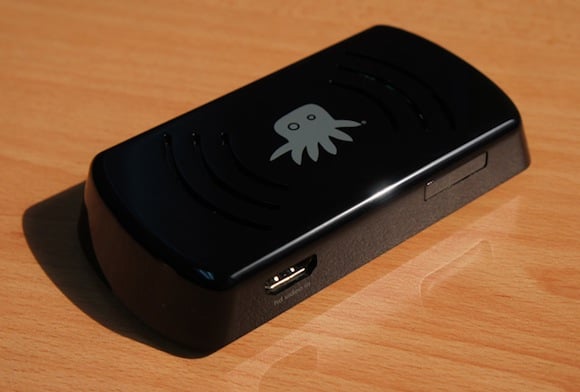Original URL: https://www.theregister.com/2011/09/16/chumby_nettv_hack/
How gizmo maker's hack outflanked copyright trolls
Chumby NeTV: A triumph for mankind
Posted in Security, 16th September 2011 04:00 GMT
When the master encryption key locking down millions of Blu-ray players and set-top boxes was mysteriously leaked last year, Hollywood moguls worried their precious high-definition movies would face a new flurry of piracy.
Instead, it spawned the Chumby NeTV, a tiny, Wi-Fi-connected box that sits between a television and a set-top box or DVD player so email alerts, Tweets and other internet content are scrolled across the bottom of the screen – all without interrupting the flow of the video.
Making the NeTV break into the encrypted video stream passing through an HDMI cable required the elite hacking skills of Bunnie Huang, an engineer and co-founder of Chumby, the maker of net-connected alarm clocks that display weather forecasts, news headlines, and other internet content. Using the leaked master key at the heart of the HDCP, or high-bandwidth digital content protection, encryption scheme to modify the content was clever enough. Doing it without violating draconian copyright laws was nothing short of brilliant.

The Chumby NeTV in all its glory
That's because HDCP was created by Intel for the express purpose of thwarting piracy by restricting access to video passing between set-top boxes and TVs. It establishes a secret key that's unique to each pair of devices, creating a barrier for would-be pirates out to capture and copy the high-definition content. Tampering with this scheme runs the risk of violating the Digital Millennium Copyright Act, a law that carries stiff criminal and civil penalties for circumventing technology intended to prevent access to copyrighted material.
Ignorance is bliss
Faced with the challenge of crashing the party that only HDCP-compliant devices can join without running afoul of the DMCA, Huang employed the leaked master key in a way that allows the Chumby NeTV to use the shared secret key to inject Tweets and other content into the encrypted stream without decrypting the restricted video. His device intentionally remains oblivious to the protected work, a distinction he believes keeps it from violating the law's anti-circumvention provisions.
“It's important to note that nowhere in the pipelines is the video data decrypted,” Huang wrote in an email to The Register. “We don't use the master key to break any locks, or circumvent any copyright protection. We use it to enable interoperability and we do so without ever decrypting the source data: encrypted pixels are just replaced with different encrypted pixels.”
Huang's claims have been confirmed by two experts.
“What's interesting here is that although the device does have the keys needed to do decryption, it isn't actually doing that,” Keith Irwin, a professor of computer science at Winston-Salem State University in North Carolina, wrote in an email. “A conceptually simple means of modifying encrypted video would be to have the NeTV decrypt the video signal from the video device, modify it, then re-encrypt it. However, this isn't what the NeTV does.”
Cryptographer Nate Lawson, who heads the Root Labs security consultancy, has analyzed the open-source code that runs the NeTV and provides an analysis here.
'Legal bullies on the technology playground'
The hack was helped along with a series of fortunate events. The first was a September 2010 post on Pastebin.com that contained the master key that ultimately derives the shared keys that encrypt video as it passes from a set-top box or DVD player to a monitor. More than 12 months later, no one knows who authored the key or whether it was found mathematically or just leaked by an insider. Ultimately, it didn't matter: The secret protecting the scheme was irreversibly revealed.
Another lucky happenstance was the HDCP's use of a stream cipher to encrypt content, making it possible to combine it seamlessly with other encrypted signals that use the same key. This allowed Huang to use the leaked master key to encrypt the NeTV feed and inject it into the stream without ever having to convert anything into plaintext. Had HDCP used a block cipher, this task would have been significantly more limited.
Huang's hack was also noteworthy for its ability to inject content into the feed without causing hiccups in the the video or audio, something that's not easy to do with a device that uses an 800 MHz processor. One of the ways he worked around the bottle neck was the use of chroma key compositing, the technique involving green screens videographers have used for years to seamlessly overlay one video feed into another.
Of course, the absence of any decryption by the NeTV is no guarantee Chumby won't be sued by a device maker or content provider who doesn't like the idea of an outsider joining the HDCP camp without an invitation. People modifying Sony's PlayStation or Microsoft's Xbox game consoles and Texas Instruments calculators know first hand how touchy device makers can be about these kinds of hacks.
The risk hasn't escaped the notice of Huang, who is scheduled to demo the NeTV hack at Sunday's Maker Faire at the New York Hall of Science.
“While I'm hoping that everyone will engage in mature, rational and fair discourse, the fact exists that there *are* legal bullies on the technology playground and they have a lot of tricks in their bag, and a lot of ammunition to hurl at people they don't like,” he wrote. “But, what will the world come to if all innovative thoughts end at lawyers, and not at users? I think it would be a sad day for consumers when small innovators spend more resources worrying about being sued than worrying about being creative.”
This story to be continued ... maybe. ®
This article was updated to correct the name of the HDCP scheme.